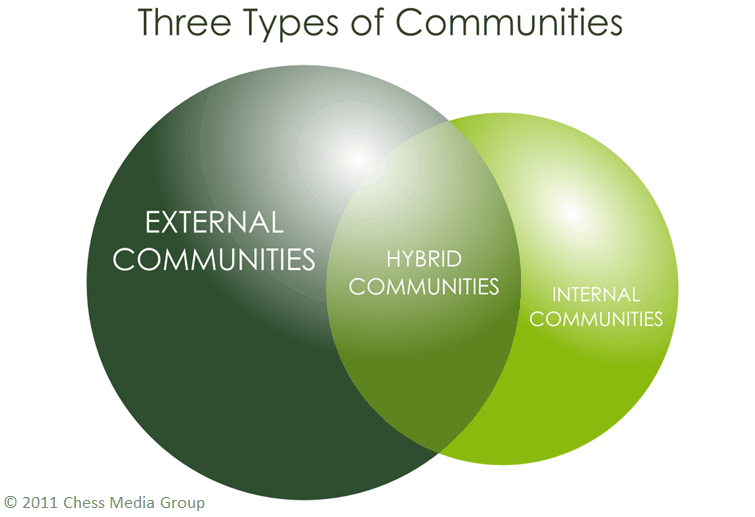When you talk about social business you can’t help but bring up the C-word. We all know what I’m talking about right? Yes, communities! Now, when most people or organizations think of communities they actually think of customer communities, however there is more than one type of community that organizations need to think about. So, in Chess Media Group style we decided to make a very simple visual to show the three types of communities that exist in social business today.

External Communities
This is what most people think of when they think of communities, these are usually comprised of customers that share common ideas, interests, product purchases, or support issues. These types of external communities usually don’t have much insight into the inner workings of an organization. They typically see all of the marketing/branding speak that an organization puts out and for the most part are involved to the extent with which they can solve their problems or find information. Their feedback is considered by the organization and incorporated on a general scale. Customer communities such as these are all over the place, many brands such as Nike, Zappos, SAP, Microsoft, Best Buy, and Barnes & Noble all have customer communities.
Hybrid communities
We don’t hear about these as often as we should but an example of a hybrid community is between a company such as Walmart and all of it’s suppliers (I’m sure there are thousands) or perhaps a loyal community of superusers for a particular brand or product and employees of that organization looking to make a strategic business decisions (perhaps around marketing, pricing, or feature set). In these types of communities the customers, partners, or suppliers have much more insight into how the organization operates and conducts business. These community members also impact business decisions that the organization makes. For example, a supplier community may provide valuable feedback to Walmart which impacts it’s forecasting. Hybrid communities are very strategically created as there is a certain level of trust that an organization needs to be comfortable with (since it is oftentimes sharing confidential and proprietary data). These communities are called “hybrid” because they are not quite completely on the outside of the organization nor are they completely on the inside, they straddle the line between both.
Internal communities
These exist for employees only and we are seeing more and more of these types of communities implemented within organizations. Typically these communities are fostered and are easily created after deploying internal collaboration tools such as Sharepoint. These communities allow employees to share information, find subject matter experts, and collaborate on necessary projects. These types of communities ideally are made up of everyone from entry level employees to senior level managers. Technology adoption is oftentimes a challenge here as employees may or may not choose to use new collaborative tools to work with and interact with each other.
These are the three types of communities that organizations need to consider when developing a social business strategy. Each type of community serves a different purpose. The ideal “social business” scenario is for an organization to implement a combination of all of the above.
Hopefully this makes sense, any questions or comments?

Comments